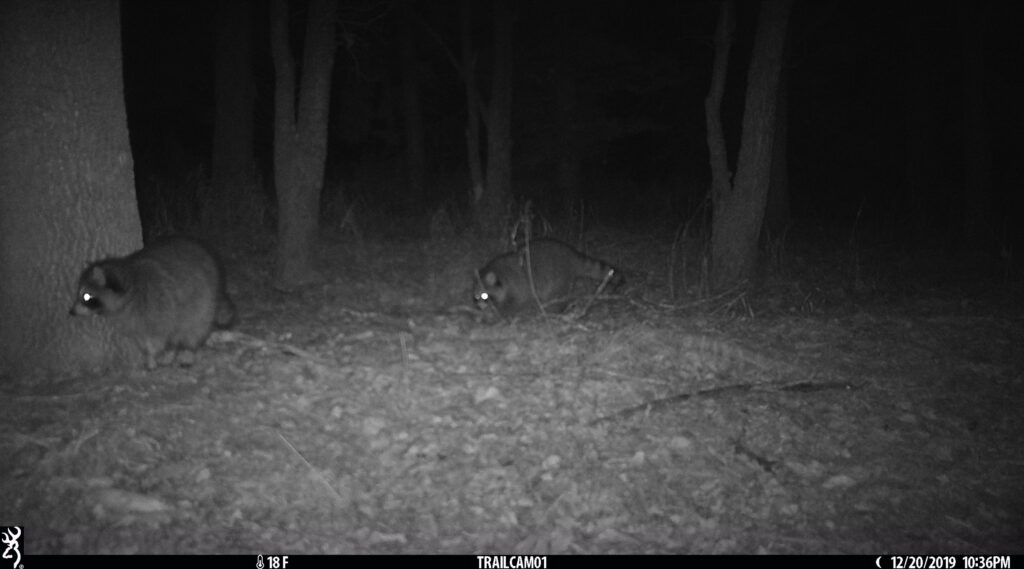
Is Light Pollution Affecting the Wildlife in My Woods?
By Emily Oyos
Star-gazing has been a favorite pastime for millennia, but these days, it often seems like stars are growing dimmer and decreasing in number. The likely culprit? Light pollution.
With a simple flip of the switch, we can illuminate a room, a backyard, or even an entire building. Lights are crucial to our functioning as human beings—they allow us to see after nightfall and sometimes even provide a sense of security when we are alone at night. However, we often fail to consider the effect artificial lights have on the environment. From insects to birds to mammals to even trees, light pollution is having detrimental effects on the natural communities with whom we share the earth.
Each year, scientists estimate that light pollution continues to grow at a two percent rate, twice the population growth rate. Currently, over 99% of the United States is affected by light pollution. Even if you think you live in a rural wooded area, you are likely still experiencing the effects of this lesser-known pollutant. Using this interactive map, you can see the amount of artificial light produced in your home place.

While humans are asleep in their beds, many animals are just starting their day, or rather, their night. In the United States, 70% of birds are migratory, and of those, 80% migrate at night. The majority of night migrators use the moon and stars to guide them on their journey. But what happens when city lights disrupt their migratory path? Some birds can circumnavigate the city and continue on their way unharmed. Unfortunately, for many birds, the city lights disorient them, pulling them into the street lamp-lined roadways and windowed buildings below. While some make it out, others crash into windows or get stuck flying around in the light until they eventually die from exhaustion. As cities expand and interrupt common migratory pathways, this problem will continue to increase unless we take immediate action.
In addition to the detrimental effects on birds, light pollution is also responsible for billions of insect deaths each year. The common phrase “like a moth to a flame” could not be more relevant when it comes to light pollution. Artificial lights draw in some insects, with approximately one-third of those circling creatures estimated to die by the following morning. Other insects, such as the firefly, rely on bioluminescence to locate a mate. Excess artificial lights can block their natural signals, thus playing a role in their population decline. Turning off your porch or other outside lights before going to bed can save thousands of insects throughout your lifetime.
Other creatures in the animal kingdom are experiencing similar effects from artificial lights. The circadian rhythm of many mammals is thrown off, with diurnal species experiencing longer days and nocturnal species experiencing shorter nights. This change has disrupted predator/prey relationships, and some mammals have experienced increased growth in cancerous tumors. Amphibians, such as frogs and toads, who partake in nighttime croaking as part of their breeding cycle, have suffered a decline in population due to artificial lights interfering with a historically dark sky. Even humans are being affected by our own invention with artificial lights causing a change in melatonin levels, thus leading to an increase in cancer, diabetes, and mood disorders.


If everything listed above was not enough to convince you that light pollution is a problem, research has found that trees are also affected by this nighttime disruption. (Don’t worry, we will get to potential solutions soon!) Trees sensitive to day length tend to be more affected by artificial light. A change in day length can cause disruptions in flowering patterns, and some trees may grow larger leaves, leading them to be more susceptible to water stress and air pollution. This change can also prevent trees, especially young ones, from entering dormancy in the fall. The trees most affected by artificial light include maples, birches, elms, dogwoods, and cottonwoods.
Let’s face it, the effect of light pollution on trees, wildlife, and even humans is not an uplifting story. So, what can you do to help protect your natural community?
One of the most significant changes you can make is purchasing or installing direction covers on outdoor lights. These covers shield the light source, thereby minimizing glare and skyglow. Examples of shielded light fixtures are pictured below. Motion sensor lights are another great option as they automatically turn off once motion is no longer detected. If you are turning lights on manually, make sure to light only the area you need and turn them off again upon leaving the space.

Light brightness and color are two other factors to take into consideration. Warm color lights are less likely to endanger wildlife and draw in insects. Insects, in particular, are most drawn to shades of blue and white. Due to their high energy efficiency and longer lifespan, LEDs are becoming more and more popular. However, these bright lights tend to emit large amounts of blue light. If you use LEDs, experts recommend choosing warm-white or warm-color filtered LEDs. To find dark-sky friendly approved lighting, we recommend checking out this page from the International Dark-Sky Association.
Whether you live in the city or rural Wisconsin, light pollution affects each and every one of us. By making small changes in outdoor lighting and our everyday routine, we can collectively begin to reduce light pollution. For more information on the effects of light pollution and how to join the dark sky movement, visit https://www.darksky.org/.
To learn more, check out:
https://www.smithsonianmag.com/smart-news/light-pollution-contributes-insect-apocalypse-180973642/
https://www.bbc.com/future/article/20210719-why-light-pollution-is-harming-our-wildlife
https://www.extension.purdue.edu/extmedia/fnr/fnr-faq-17.pdf
https://myfwc.com/conservation/you-conserve/lighting/pollution/
